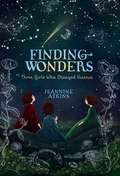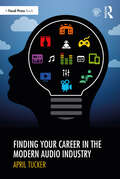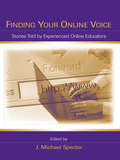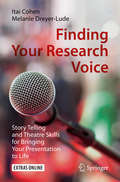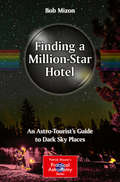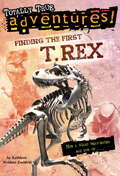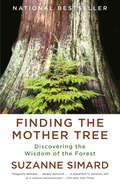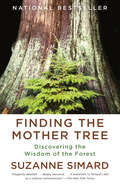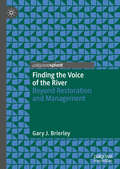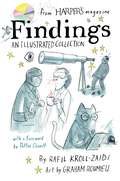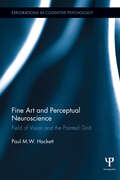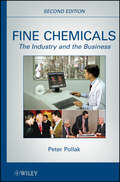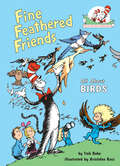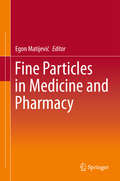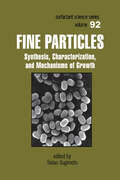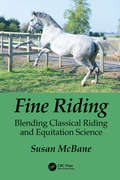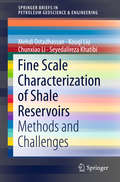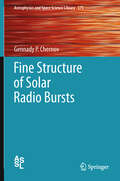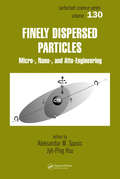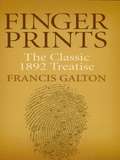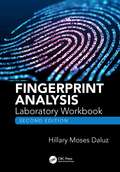- Table View
- List View
Finding Wonders: Three Girls Who Changed Science (Girls Who Love Science)
by Jeannine AtkinsThis &“evocative and beautiful&” (School Library Journal) novel &“vividly imagines the lives of three girls&” (Booklist, starred review) in three different time periods as they grow up to become groundbreaking scientists.Maria Merian was sure that caterpillars were not wicked things born from mud, as most people of her time believed. Through careful observation she discovered the truth about metamorphosis and documented her findings in gorgeous paintings of the life cycles of insects. More than a century later, Mary Anning helped her father collect stone sea creatures from the cliffs in southwest England. To him they were merely a source of income, but to Mary they held a stronger fascination. Intrepid and patient, she eventually discovered fossils that would change people&’s vision of the past. Across the ocean, Maria Mitchell helped her mapmaker father in the whaling village of Nantucket. At night they explored the starry sky through his telescope. Maria longed to discover a new comet—and after years of studying the night sky, she finally did. Told in vibrant, evocative poems, this stunning novel celebrates the joy of discovery and finding wonder in the world around us.
Finding Your Career in the Modern Audio Industry
by April TuckerFinding Your Career in the Modern Audio Industry equips the reader with the skills they need to turn an interest in audio, sound, or music technology into a career. This book provides insight for aspiring professionals seeking audio-related opportunities in entertainment, technology, education, and more. In the audio industry, there is typically a gap between those in-training and those with professional (and financially sustainable) careers. This book bridges the information gap, offering practical and real-world advice to those in this volatile stage of their career. Including 70+ interviews with professionals from over 20 countries, Finding Your Career in the Modern Audio Industry offers insight into how others (across the industry and the world) have applied entrepreneurial thinking, problem-solving, and creative solutions to build their careers. Including international case studies and interviews with diverse professionals, Finding Your Career in the Modern Audio Industry is essential reading for anyone taking their first steps into an audio-related field.
Finding Your Online Voice: Stories Told by Experienced Online Educators
by J. Michael SpectorFinding Your Online Voice offers a thought-provoking discussion of innovative approaches to technology-based distance education. Editor J. Michael Spector focuses on how highly experienced teachers conceptualize and organize online classes. Best practices and guidelines for effective online teaching as well as a set of instructor skills speci
Finding Your Research Voice: Story Telling and Theatre Skills for Bringing Your Presentation to Life
by Melanie Dreyer-Lude Itai CohenLearning to tell a compelling research story can have a significant impact on your career. It can make you stand out at professional conferences, on the job market, or during an ideal networking opportunity. It is easy to tell a research story badly. It takes time and effort to learn to tell a research story well. This compact and engaging volume presents a series of techniques followed by theatre-inspired, field tested exercises that will help you improve your research presentations. Once you’ve learned how to create a dynamic live performance of your research story, you may find that this professional obligation is no longer something to dread, and may even become a highlight of your research experience.
Finding a Million-Star Hotel
by Bob MizonBob Mizon, one of the world's best known campaigners against the veil of light pollution that has taken away the starry sky from most of the world's population, takes readers to a hundred places in the UK and the USA where the wonders of the night sky might still be enjoyed in perfect or near-perfect night skies. Visiting small hotels and simple campsites, and savoring vast dark-sky reserves where the night sky is actively protected, The Million-Star Hotel celebrates the black skies of yesteryear - which may become a reality for more and more of us as modern technology reins in lighting and puts it only where needed. How can you prepare for your stay beneath the stars? What astronomy can you do during the daytime? What kind of equipment will you need? Questions such as these are answered, and if town dwellers return inspired - and, Bob hopes, also inspired to look with fresh eyes at their own local lighting - there is enough information here for them to equip themselves for some urban astronomy too.
Finding our Place in the Solar System: The Scientific Story of the Copernican Revolution
by Paul Wallace Todd TimberlakeFinding our Place in the Solar System gives a detailed account of how the Earth was displaced from its traditional position at the center of the universe to be recognized as one of several planets orbiting the Sun under the influence of a universal gravitational force. The transition from the ancient geocentric worldview to a modern understanding of planetary motion, often called the Copernican Revolution, is one of the great intellectual achievements of humankind. This book provides a deep yet accessible explanation of the scientific disputes over our place in the solar system and the work of the great scientists who helped settle them. Readers will come away knowing not just that the Earth orbits the Sun, but why we believe that it does so. The Copernican Revolution also provides an excellent case study of what science is and how it works.
Finding the First T. REX
by Kathleen Weidner ZoehfeldIN 1902, WILLIAM HORNADAY handed a map to the famous paleontologist Barnum Brown. It was Hornaday’s hand-drawn directions to a remote area of the Montana Badlands, where he believed amazing dinosaur fossils lay buried. Following the map, Brown dug up a jawbone edged with six-inch long teeth, the remains of a monstrous creature no one had ever seen before. But one bone wasn’t enough, and Brown soon found himself in a desperate race to discover the skeleton of the mystery carnivore! From the Trade Pap...
Finding the First T. Rex (Totally True Adventures)
by Kathleen Weidner Zoehfeld Jim NelsonIN 1902, WILLIAM HORNADAY handed a map to the famous paleontologist Barnum Brown. It was Hornaday's hand-drawn directions to a remote area of the Montana Badlands, where he believed amazing dinosaur fossils lay buried. Following the map, Brown dug up a jawbone edged with six-inch long teeth, the remains of a monstrous creature no one had ever seen before. But one bone wasn't enough, and Brown soon found himself in a desperate race to discover the skeleton of the mystery carnivore!From the Trade Paperback edition.
Finding the Mother Tree: Discovering the Wisdom of the Forest
by Suzanne SimardA world-leading expert shares her amazing story of discovering the communication that exists between trees, and shares her own story of family and grief. Suzanne Simard is a pioneer on the frontier of plant communication and intelligence; she&’s been compared to Rachel Carson, hailed as a scientist who conveys complex, technical ideas in a way that is dazzling and profound. Her work has influenced filmmakers (the Tree of Souls in James Cameron&’s Avatar), and her TED talks have been viewed by more than 10 million people worldwide. Now, in her first book, Simard brings us into her world, the intimate world of the trees, in which she brilliantly illuminates the fascinating and vital truths—that trees are not simply the source of timber or pulp but are a complicated, interdependent circle of life; that forests are social, cooperative creatures connected through underground networks by which trees communicate their vitality and vulnerabilities with communal lives not that different from our own. Simard describes up close—in revealing and accessible ways—how trees, living side by side for hundreds of years, have evolved; how they perceive one another, learn and adapt their behaviors, recognize neighbors, and remember the past; how they have agency about their future; how they elicit warnings and mount defenses, compete and cooperate with one another with sophistication: characteristics previously ascribed to human intelligence, traits that are the essence of civil societies. And, at the center of it all, the Mother Trees: the mysterious, powerful forces that connect and sustain the others that surround them.Simard, born and raised in the rain forests of British Columbia, spent her days as a child cataloging the trees from the forest; she came to love and respect them and embarked on a journey of discovery and struggle. Her powerful story is one of love and loss, of observation and change, of risk and reward. And it is a testament to how deeply human scientific inquiry exists beyond data and technology: it&’s about understanding who we are and our place in the world. In her book, as in her groundbreaking research, Simard proves the true connectedness of the Mother Tree to the forest, nurturing it in the profound ways that families and humansocieties nurture one another, and how these inseparable bonds enable all our survival.
Finding the Mother Tree: Discovering the Wisdom of the Forest
by Suzanne SimardNEW YORK TIMES BEST SELLER • From the world's leading forest ecologist who forever changed how people view trees and their connections to one another and to other living things in the forest—a moving, deeply personal journey of discovery&“Finding the Mother Tree reminds us that the world is a web of stories, connecting us to one another. [The book] carries the stories of trees, fungi, soil and bears--and of a human being listening in on the conversation. The interplay of personal narrative, scientific insights and the amazing revelations about the life of the forest make a compelling story.&”—Robin Wall Kimmerer, author of Braiding SweetgrassSuzanne Simard is a pioneer on the frontier of plant communication and intelligence; her TED talks have been viewed by more than 10 million people worldwide.In this, her first book, now available in paperback, Simard brings us into her world, the intimate world of the trees, in which she brilliantly illuminates the fascinating and vital truths--that trees are not simply the source of timber or pulp, but are a complicated, interdependent circle of life; that forests are social, cooperative creatures connected through underground networks by which trees communicate their vitality and vulnerabilities with communal lives not that different from our own. Simard writes--in inspiring, illuminating, and accessible ways—how trees, living side by side for hundreds of years, have evolved, how they learn and adapt their behaviors, recognize neighbors, compete and cooperate with one another with sophistication, characteristics ascribed to human intelligence, traits that are the essence of civil societies--and at the center of it all, the Mother Trees: the mysterious, powerful forces that connect and sustain the others that surround them. And Simard writes of her own life, born and raised into a logging world in the rainforests of British Columbia, of her days as a child spent cataloging the trees from the forest and how she came to love and respect them. And as she writes of her scientific quest, she writes of her own journey, making us understand how deeply human scientific inquiry exists beyond data and technology, that it is about understanding who we are and our place in the world.
Finding the Speed of Light: The 1676 Discovery That Dazzled The World
by Mark WestonKirkus Star Mark Weston’s high-interest story and Rebecca Evans’s colorful graphics make scientific discovery the coolest thing this side of Jupiter. More than two centuries before Einstein, using a crude telescope and a mechanical timepiece, Danish astronomer Ole Romer measured the speed of light with astounding accuracy. How was he able to do this when most scientists didn’t even believe that light traveled? Like many paradigm-shattering discoveries, Romer’s was accidental. Night after night he was timing the disappearance and reappearance of Jupiter’s moon Io behind the huge, distant planet. Eventually he realized that the discrepancies in his measurements could have only one explanation: Light had a speed, and it took longer to reach Earth when Earth was farther from Jupiter. All he needed then to calculate light’s speed was some fancy geometry.
Finding the Voice of the River: Beyond Restoration and Management
by Gary J. BrierleyThis book addresses societal relationships to river systems, highlighting many unexplored possibilities in how we know and manage our rivers. Brierley contends that although we have good scientific understanding of rivers, with remarkable prospect for profound improvements to river condition, management applications greatly under-deliver. He conceptualizes approaches to river repair in two very different ways: Medean (competitive) and Gaian (cooperative). Rather than ‘managing’ rivers to achieve particular anthropogenic goals (the former option), this book adopts a more-than-human approach to ‘living with living rivers’ (the latter option), applying a river rights framework that conceptualizes rivers as sentient entities.Chapters build on significant experience across many parts of the world, emphasizing the diverse array of river attributes and relationships to be protected and the wide range of problems to be addressed. Although the book has an environmental focus, it is framed as an argument in popular philosophy, contemplating the agency of rivers as place-beings. It will be of great value to academics, students and general readers interested in protecting river systems.
Findings: An Illustrated Collection
by Graham Roumieu Rafil Kroll-ZaidiFrom the celebrated Findings column in Harper's Magazine, a selection of fantastic facts, delightfully illustrated by Graham Roumieu. Do you know that Czech and German deer still do not cross the iron curtain? Or that in Scotland, most adults say it is acceptable for a man to marry his widow's sister? How about that vanilla yogurt gives mice glossier coats and larger testicles? Or that conservatism strongly correlates with a preference for name-brand mayonnaise? Such perverse nuggets of scientific discovery are assembled in FINDINGS, the bizarre and beloved back-page column of Harper's Magazine, the nation's oldest literary monthly. Now these surreal shards of knowledge take on new life in illustrations by Graham Roumieu (author of the cult classic In Me Own Words: The Autobiography of Bigfoot). More than just a collection of facts about the sex lives of primates (though, it's that too), FINDINGS is funny, informative, and occasionally wondrous.
Fine Art and Perceptual Neuroscience: Field of Vision and the Painted Grid (Explorations in Cognitive Psychology)
by Paul HackettOver the past decade, the integration of psychology and fine art has sparked growing academic interest among researchers of these disciplines. The author, both a psychologist and artist, offers up a unique merger and perspective of these fields. Through the production of fine art, which is directly informed by neuroscientific and optical processes, this volume aims to fill a gap in the literature and understanding of the creation and perception of the grid image created as a work of art. The grid image is employed (for reasons discussed in the text) to illustrate more general processes associated with the integration of vision, visual distortion, and painting. Existing at the intersection of perceptual neuroscience, psychology, fine art and art history, this volume concerns the act of painting and the process of looking. More specifically, the book examines vision and the effects of visual impairment and how these can be interpreted through painting within a theoretical framework of visual neuroscience.
Fine Chemicals: The Industry and the Business
by Peter PollakNow updated - the authoritative reference on one of the most exciting and challenging areas of the modern chemical industry This highly readable and informative reference continues to take a comprehensive, in-depth view of the products, markets, and technology of the fine chemicals industry and business. Dr. Peter Pollak, one of the foremost authorities in the field, provides an insider's unique perspective on fine chemicals from both a technological and a commercial viewpoint, covering all recent developments. He provides ample facts and figures including sixty-three tables, thirty figures, and nineteen photo inserts - making this a well-illustrated and documented text. This reference is divided into three parts: Part One: The Industry discusses the types of fine chemical companies, the range of products and services, the role of research and development, the underlying technologies, and the challenges facing management Part Two: The Business explores the key markets for fine chemicals - such as the pharmaceutical, agrochemical, and animal health industries - and the relevant marketing strategies, as well as the ins and outs of pricing, distribution channels, intellectual property rights, account management, and promotion Part Three: Outlook examines trends such as globalization and outsourcing, forecasts future growth and development by industry segment, and discusses prerequisites for success in the field This new edition features both updated and new information on the offer/demand balance for fine chemicals and the escalating impact of emerging companies in Asia, particularly from China and India. It describes the inversion of the mergers and acquisitions scenario from a seller's to a buyer's market, the broadening of the fine chemical business model, and the expanding role of biotechnology, as well as the impact of increased outsourcing of chemical manufacturing and the growing consumption of pharmaceuticals and agrochemicals by the life science industry. Also included are numerous molecular structures, engineering diagrams, and tables to facilitate understanding. For a thorough understanding of the technology, the business, and the future of the fine chemicals industry, this book's insight is unprecedented. It is ideally suited for those in the industry - including employees, suppliers, customers, investors, and consulting companies - as well as academic and other research organizations, students and educators, public officials, media representatives, and anyone else who wants to understand the intricacies of the industry. Fine Chemicals has been recognized as Outstanding Academic Title 2012 (Choice, v.50, no. 05, January 2013).
Fine Feathered Friends: All About Birds (The Cat in the Hat's Learning Library)
by Tish RabeLaugh and learn with fun facts about hummingbirds, ducks, penguins, and more—all told in Dr. Seuss&’s beloved rhyming style and starring the Cat in the Hat! &“Birds come in all colors, all shapes, and all sizes, and live in a world that is full of surprises!&” The Cat in the Hat&’s Learning Library series combines beloved characters, engaging rhymes, and Seussian illustrations to introduce children to non-fiction topics from the real world! Spread your wings and learn: how the chickadee got its namehow penguins take care of their babieswhy male whooping cranes danceand much more!Perfect for story time and for the youngest readers, Fine Feathered Friends: All About Birdsalso includes an index, glossary, and suggestions for further learning. Look for more books in the Cat in the Hat&’s Learning Library series!High? Low? Where Did It Go? All About Animal CamouflageIs a Camel a Mammal? All About MammalsThe 100 Hats of the Cat in the Hat: A Celebration of the 100th Day of SchoolA Great Day for Pup: All About Wild BabiesWould You Rather Be a Pollywog? All About Pond LifeHappy Pi Day to You! All About Measuring CirclesI Can Name 50 Trees Today! All About TreesMy, Oh My--A Butterfly! All About ButterfliesOh Say Can You Seed? All About Flowering PlantsInside Your Outside! All About the Human BodyIce is Nice! All About the North and South Poles
Fine Particles in Medicine and Pharmacy
by Egon MatijevićPharmaceutical manufacture is very exacting - for example, drugs must be uniform in size, shape, efficacy, bioavailability, and safety. The presence of different polymorphs in drug production is a serious problem, since different polymorphs differ in bioavailability, solubility, dissolution rate, chemical and physical stability, melting point, color, filterability, density, and flow properties. Fine Particles in Medicine and Pharmacy discusses particle size, shape, and composition and how they determine the choice of polymorph of a drug.
Fine Particles: Synthesis, Characterization, and Mechanisms of Growth (Surfactant Science)
by Tadao Sugimoto"The first comprehensive book on fine particle synthesis that ranges from fundamental principles to the most advanced concepts, highlighting mondispersed particles from nanometers to micrometers. Describes mechanisms of formation and specific characteristics of each family of compounds while identifying problems and proposing solutions. Contains su
Fine Riding: Blending Classical Riding and Equitation Science
by Susan McBaneEquitation Science together with classical riding is today probably the most humane, effective, and practical way of training and enjoying the horse, competitive or not. To avoid getting involved is to accede to the status quo. Our horses deserve better.~Sharon E. Cregier, Ph.D., FIASH (Hon., Edin.), founding member of Equine Behaviour Forum In precise, practical language, Fine Riding describes how to blend the principles of classical riding with the modern findings of Equitation Science, demonstrating how to put the principles into practice when training and riding horses. The book encompasses the author's lifelong background in authentic classical riding and a 17-year study and practice of Equitation Science. It presents the best of the old with the best of the new, resulting in a unique and rational blend of principles, clearly explained, that enables and encourages readers to train, ride and care for their horses truly effectively and humanely. Applicable to riding of all schools of thought, from hacking to racing, including jumping, McBane's method is more than simply another ‘system’ of riding. It applies the results of rigorous scientific studies to the historical, classical training and riding of horses in an ethical, humane and effective way, explaining the principles in such a way that readers will feel able to put it into effect themselves. This book will encourage horse owners to serve their horses with renewed understanding and commitment.
Fine Scale Characterization of Shale Reservoirs: Methods And Challenges (Springerbriefs In Petroleum Geoscience And Engineering Ser.)
by Mehdi Ostadhassan Kouqi Liu Chunxiao Li Seyedalireza KhatibiThis book summarizes the authors' extensive experience and interdisciplinary approach to demonstrate how acquiring and integrating data using a variety of analytical equipment can provide better insights into unconventional shale reservoir rocks and their constituent components. It focuses on a wide range of properties of unconventional shale reservoirs, discussing the use of conventional and new analytical methods for detailed measurements of mechanical properties of both organic and inorganic constituent elements as well as of the geochemical characteristics of organic components and their origins. It also addresses the investigation of porosity, pore size and type from several perspectives to help us to define unconventional shale formation. All of these analyses are treated individually, but brought together to present the rock sample on a macro scale. This book is of interest to researchers and graduate students from various disciplines, such as petroleum, civil, and mechanical engineering, as well as from geoscience, geology, geochemistry and geophysics. The methods and approaches can be further extended to biology and medicine.
Fine Structure of Solar Radio Bursts
by Gennady P. ChernovThe study of the fine structure of solar radio emissions is key to understanding plasma processes in the solar corona. It remains a reliable means for both diagnosing the corona and verifying the results of laboratory plasma experiments on wave-wave and wave-particle interactions. This monograph provides a comprehensive review of the fine structure of solar radio bursts. Based on the diversity of experimental data resulting from the progress made in observational techniques, the validity of various theoretical models is reexamined. The book serves as an up-to-date reference work for all researchers in this field.
Fine-Tuning in the Physical Universe
by Roger Davies David Sloan Rafael Alves Batista Michael Townsen HicksIs the universe fine-tuned for complexity, life, or something else? This comprehensive overview of fine-tuning arguments in physics, with contributions from leading researchers in their fields, sheds light on this often used but seldom understood topic. Each chapter reviews a specific subject in modern physics, such as dark energy, inflation, or solar system formation, and discusses whether any parameters in our current theories appear to be fine-tuned and, if so, to what degree. Connections and differences between these fine-tuning arguments are made clear, and detailed mathematical derivations of various fine-tuned parameters are given. This accessible yet precise introduction to fine-tuning in physics will aid students and researchers across astrophysics, atomic and particle physics and cosmology, as well as all those working at the intersections of physics and philosophy.
Finely Dispersed Particles: Micro-, Nano-, and Atto-Engineering
by Aleksandar M. Spasic Jyh-Ping HsuOver the last decade, the biggest advances in physical chemistry have come from thinking smaller. The leading edge in research pushes closer to the atomic frontier with every passing year. Collecting the latest developments in the science and engineering of finely dispersed particles and related systems, Finely Dispersed Particles: Micro-, Nano-, a
Finger Prints: The Classic 1892 Treatise
by Francis GaltonLandmark discusses the evidence validating fingerprints as a means of personal identification, permanence of the fingerprint characteristics, uniqueness of an assemblage of ridge details, and the variability and classifiable nature of finger patterns -- along with such fundamental investigations as biological and racial variations and the inheritance of fingerprint traits. 34 tables. 15 plates.
Fingerprint Analysis Laboratory Workbook, Second Edition
by Hillary Moses DaluzFingerprint collection and analysis may be performed as part of many jobs, including crime scene technician, latent print examiner, criminalist, and lab supervisor. Regardless of one’s specific background or role in the process, a knowledge of scientific practices is critical in handling and analyzing fingerprint evidence. The best way to understand the principles and concepts of any science learned in a classroom is to perform experiments. The exercises in Fingerprint Analysis Laboratory Workbook, Second Edition address all aspects of fingerprint theory, investigation, processing, comparisons, and research. Designed specifically to parallel the Fundamentals of Fingerprint Analysis, Second Edition textbook, the laboratory exercises correspond with the textbook chapters, with exercise in the lab chapter putting into practice the concepts covered in the text chapter. Each lab follows the same format, beginning with the objectives of the experiment and providing the background information necessary to perform the experiment. This is followed by a list of required materials, the lab exercises, and post-lab questions for students to test what they’ve learned. Many of the laboratory exercises may be completed either at home or in a laboratory setting. Exercises and photographs enhance the text, making it an ideal hands-on learning tool. New techniques and current practices added to the primary textbook have been included in this companion laboratory workbook to cover the latest in real-world application of fingerprint analysis science to practice.
